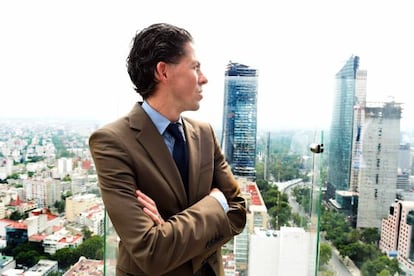“I’ve been preparing for this all my life”
Carlos Slim’s son-in-law is partnering with architect Norman Foster to build Mexico City’s new airport

Looking out from the studio of architect Fernando Romero, the skies of Mexico City open up to show a lone plane crossing the horizon. They head past at the rate of one every minute. Regular as clockwork, this particular aircraft takes the curve cleanly and prepares to land at Benito Juárez airport.
Romero, a tanned, smart, supple-looking man, watches the aerial parade with an amused look in his eyes, knowing full well that its days are numbered.
Last Tuesday, Mexican authorities unveiled the winner of an international bid to build a new international airport for the capital: the joint project by renowned British architect Sir Norman Foster and Fernando Romero, who is son-in-law to businessman Carlos Slim, the nation’s wealthiest man and second only to Bill Gates on Forbes’ list of richest people in the world.
The Foster-Romero team beat out other “starchitects” such as Richard Rogers and Zaha Hadid, both Pritzker Prize recipients just like Foster.
The project, the largest to be carried out in Mexico in the coming years, is destined to become the emblem of an era.
“The sheer scale of it is monumental, like other sites of our national architecture. It will be a great gateway into Mexico,” says Romero, 42, who talks about the project with passion and precision, grabbing the reporter’s pen and notebook to sketch out the future airport.
Question. How would you define your architecture?
Answer. I am very interested in ensuring that buildings will represent their own era. Architecture is a process of translation. Every context has its own information. That skyscraper made for a bank across from Chapultepec [he points at it with his finger] is not the same thing as the airport. This latest project is a chance to create a great piece of infrastructure for the country. We are going through an extraordinary moment in terms of democratic development. Great reforms have been passed, including some major ones such as the energy bill. This new project has the potential to encapsulate Mexico’s current moment.
Q. What new elements did you add to the competition’s basic requirements?
A. The initial plan was for two buildings connected by a train link. We opted for a single efficient building that would eliminate the need for trains. These create technical problems, require a lot of maintenance work and create cost overruns, particularly with this soil, which is very complex because it sits on top of the old Texcoco lake. A tunnel could have put the entire timetable and even the operation of the airport at risk. We devoted a lot of energy to creating a single building with capacity for 50 million passengers a year, and this had an impact on the scale of the project. Besides that, we managed to make the most sustainable airport in the world, and created a unique building that will connect with Mexico and its symbols.
Q. How does it connect with Mexican traditions?
A. Since the days of the pyramids until now, not forgetting the colonial era, our architecture has always been monumental in scale, and this building celebrates that dimension. The central area has a clear space of 170 meters where the commercial establishments will be concentrated. The airport will enable us to adapt to the evolution of time. Air technology will change a lot in the coming years.
Q. Your design incorporates very Mexican symbols such as the eagle, the snake and the nopal cactus. Why did you choose these?

A. There is a diagram that is the sun of the project, the center that reminds you of our monumental scale. This great space is the gateway to Mexico and your time inside the terminal. You have this space to circulate in, an area that is bathed in natural light. The symbols are clear. We thought it would be interesting to incorporate the Aztec legend about the eagle that eats a snake while perched on a nopal, indicating the capital’s foundational site. That is why the great boulevard that leads you into the city by car is reminiscent of a snake, and embraces the parking lot. The roof is covered by cacti, which are very sustainable plants and Mexico has the world’s greatest diversity of them. This way, one’s first experience coming into the airport is the roof, which reminds you of the experience of flying and the eagle.
Q. The structure seems very light.
A. That’s Norman Foster’s doing, and it speaks of the essence of the project. Unlike other airports, what we managed here is for a single membrane to do everything, and act both as the space itself and the ceiling. Everything is very simplified.
Q. What was it like working with Foster? You have worked with French architect Jean Nouvel in the past.
A. The government wanted some Mexican participation, but it also wanted to build a world-class building. Each team sought its own partners, and I had the good fortune to meet Foster. He wanted to work with someone young yet interested in contemporary architecture and with sufficient experience to work well with him. We had many business meetings. He is really interested in this project. It’s been a year of highly successful collaboration.
Q. Do you feel comfortable building the symbol of an era?
A. The truth is I’ve been preparing for it all my life. This is what I always wanted to do. I had a conversation with [Pedro] Ramírez Vázquez [the Mexican architect of the Azteca soccer stadium who died last year], I worked with him, I designed alongside him, I studied what Latin American architects were doing to consolidate various moments. I am convinced of architecture’s potential to materialize a historical moment.
Q. What more is there left for you to do? Will you ever surpass this project?
A. There is no question that this will be a unique opportunity in my life.
Q. If you had to point out which part of the airport’s design carries your personal seal, which would it be?
A. Absolutely everything.
Tu suscripción se está usando en otro dispositivo
¿Quieres añadir otro usuario a tu suscripción?
Si continúas leyendo en este dispositivo, no se podrá leer en el otro.
FlechaTu suscripción se está usando en otro dispositivo y solo puedes acceder a EL PAÍS desde un dispositivo a la vez.
Si quieres compartir tu cuenta, cambia tu suscripción a la modalidad Premium, así podrás añadir otro usuario. Cada uno accederá con su propia cuenta de email, lo que os permitirá personalizar vuestra experiencia en EL PAÍS.
En el caso de no saber quién está usando tu cuenta, te recomendamos cambiar tu contraseña aquí.
Si decides continuar compartiendo tu cuenta, este mensaje se mostrará en tu dispositivo y en el de la otra persona que está usando tu cuenta de forma indefinida, afectando a tu experiencia de lectura. Puedes consultar aquí los términos y condiciones de la suscripción digital.







































